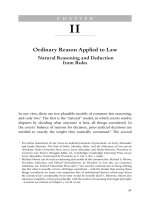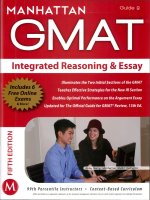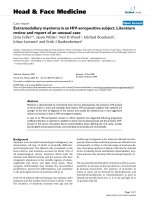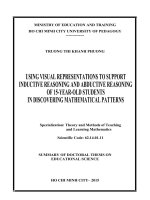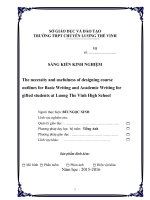Syllabus course k48 subject legal reasoning and legal methodology
Bạn đang xem bản rút gọn của tài liệu. Xem và tải ngay bản đầy đủ của tài liệu tại đây (547.19 KB, 50 trang )
<span class="text_page_counter">Trang 1</span><div class="page_container" data-page="1">
<b>SYLLABUS COURSE K48 </b>
<b>SUBJECT: LEGAL REASONING AND LEGAL METHODOLOGY </b>
<b>FIRST SEMESTER – ACADEMIC YEAR 2023 – 2024 </b>
<i><b>(Internal use only) </b></i>
</div><span class="text_page_counter">Trang 3</span><div class="page_container" data-page="3"><b>SUPPORTIVE STUDYING MATERIAL FOR THE SUBJECT: LEGAL REASONING AND LEGAL METHODOLOGY </b>
<b>FOR HIGH-QUALITY STUDENTS IN THE FIRST SEMESTER ACADEMIC YEAR 2022 – 2023 </b>
<b>--- </b>
<b>PART I: OUTLINE OF THE SUBJECT 1. Title of the subject: Legal reasoning and legal methodology </b>
<b>2. Number of credits: 02 credits (20 hours for lectures and 20 hours for discussions and presentations). </b>
<b>3. Objectives of the subject: 3.1. Objectives of knowledge </b>
<b>After studying the subject, students shall: </b>
− understand the narrow and broad meanings of legal reasoning and skills needed for legal reasoning
− understand and be able to analyse the art of legal reasoning and the technique of reading texts about law and text of the law
− analyse and apply different legal writing styles
− construct and master legal argument, including written and oral arguments.
<b>3.2. Objectives of skills </b>
After studying this subject, students shall have the capacity: − To identify issues in legal cases
− To de-construct legal arguments to point out their strengths and weaknesses − To present legal arguments effectively
<b>3.3. Objectives of attitudes </b>
The subject is designed to help students having positive attitudes towards legal reasoning and legal methodology, paying attention on how legal arguments are constructed and whether they are effective.
<b>4. Method of teaching </b>
The methods used in delivering the subject include giving lectures, presentation, case study, and group discussion.
</div><span class="text_page_counter">Trang 4</span><div class="page_container" data-page="4"><b>5. Methods of evaluation </b>
- 40 % of the final mark for assignments
- 60% of the final mark for examination in the end of the course.
<b>6. The detailed outline of the course </b>
</div><span class="text_page_counter">Trang 5</span><div class="page_container" data-page="5"><b>CHAPTER 1: INTRODUCTION TO LEGAL REASONING </b>
<i>Time: 8 theoretical hours and 6 discussion and presentation hours </i>
<b>1. Concept </b>
− Broad sense: “The psychological processes undergone by judges in reaching decisions in the cases before them”
− Narrow sense: “The arguments that judge gives, frequently in written form, in support of the decisions they render”.
<b>2. Purpose of legal reasoning study </b>
The study of legal reasoning in the broad sense = the study of judicial psychology and biography → to know judges and their psychology and to understand what impacts judges’ decisions
The study of legal reasoning in the narrow sense = an inquiry into the “logic” of judicial decision making:
− kinds of arguments judges give
− the relationship between the reasons and the decisions, the adequacy of these reasons as support for the decisions
− Applying this knowledge in one’s career
<b>3. Skills required for legal reasoning study </b>
<i>a. Critical thinking skills </i>
Critical thinking skills include: − Reasoning logically
− The ability to locate underlying assumptions (searching for hidden assumptions; justifying your own assumptions; judging the rationality of those assumptions; testing the accuracy of those assumptions).
− Analystic and argument skills
<i>b. General and specific language skills. c. Intellectual and technical skills </i>
</div><span class="text_page_counter">Trang 6</span><div class="page_container" data-page="6">− How to locate primary and secondary sources of materials
Primary source: Direct evidences or original sources of information created at the time the event occurred
Secondary source: Derived from primary source written about primary sources to analyze, interpret, and discuss information about the primary source
Comparing differences between primary and secondary sources:
▪ Created at the time of an event, or very soon after.
▪ Created by someone who saw or heard an event themselves.
▪ Created after event; sometimes a long time after something happened.
▪ Expresses an opinion or an argument about a past event.
▪ Often uses primary sources as examples.
Notes: To evaluate if the source is primary or secondary → check the context and purpose of its use.
Analysing different types of material used in legal context regarding their types of sources.
− How to read texts of the law and the texts about law − How to write (using references, summaries, notes)
</div><span class="text_page_counter">Trang 7</span><div class="page_container" data-page="7"><b>1. The language as a professional tool in legal reasoning </b>
− The role of language in legal reasoning: a professional tool − The characteristics of legal language
<i>+ ordinary words with specialized meaning (law suit) </i>
<i>+ Latin words and phrases (mens rea – guilty mind, actus reus - conduct) + Norman French (per se) </i>
+ Claims that words can be used with precision
+ Ritualized word forms (ex: the truth, the whole truth and nothing but the truth) + Use of words with flexible meanings (reasonable)
<b>2. Predictive writing and persuasive writing </b>
<i>a. Predictive writing </i>
Two purposes of predictive writing: to advise clients and to plan litigation Functions of predictive writing:
− predicts the outcome of a legal question by analyzing the authorities governing the question and the relevant facts that gave rise to the legal question
− explains and applies the authorities in predicting an outcome, and ends with advice and recommendations
− serves as record of the research done for a given legal question
<i>b. Persuasive writing </i>
<b>Persuasive writing = the most rhetorically stylized, framed as an argument and argues </b>
for one approach to resolving the legal matter and does not present a neutral analysis Functions of predictive writing:
− to persuade a deciding authority to favorably decide the dispute for the author's client, usually submitted to judges (but also to mediators, arbitrators, and others) − to persuade the dispute's opposing party.
<b>3. Planning, rewriting, and work habits </b>
− Well organized
</div><span class="text_page_counter">Trang 8</span><div class="page_container" data-page="8">− Complete − Clear − Concise − Forceful
− Accurate and precise…
Criteria for effective legal writing:
<b>1. Clarify and vividness: </b>
This criteria requires:
− find the “right” word in order to present the ideas straightforward, and avoid the word that blurs meaning.
− Figure out exactly what should be said and then say it precisely (be confident of writing and reduce fear).
<b>2. Conciseness </b>
Concise writing is by nature clear and short.
The typical readers of legal reasoning have no time to spare, therefore, they will either resent inflated verbiage or will simply refuse to read it.
<b>3. Forcefulness </b>
Forceful writing leads the reader through ideas by specifying their relationships with one another and by identifying the ideas that are most important or completing.
Relationships between ideas can be made clear through transitional words and phrases, and through demonstrative sentence structure.
Note that:
− Some transitional words and phrases are stronger than others.
− Be careful to select those that accurately represent the relationship at hand and that claim neither too little nor too much.
<b>4. Punctuation and other rules of grammar </b>
</div><span class="text_page_counter">Trang 9</span><div class="page_container" data-page="9"><b>IV. PARAGRAPHING </b>
<b>1. Organization in writing and paragraphing </b>
Why should we divide our writing into paragraphs?
<b>Two goals of paragraphing: </b>
− break your material up into digestible chunks.
− to help you discipline yourself to confront and develop each theme inherent in the material.
<b>2. Thesis sentences, topic sentences, and transition sentences </b>
2.1 Thesis sentence
− a sentence (or two) that states what you are going to do in your document as a whole. − a kind of a signpost – something that tells you where to go - or a map that shows the
reader what direction your paragraphs will take. − Normally comes at the end of the introduction
2.2 Topic sentence
− A topic sentence is often the first sentence in a paragraph.
− The topic sentence should identify the main idea and point of the paragraph, should not be too general or too specific.
− A good topic sentence is concise and emphatic. It is no longer than the idea requires, and it stresses the important word or phrase.
− The supporting details in the paragraph will develop or explain the topic sentence. 2.3 Transition sentence
Transitions are the sentences or words that allow readers to follow the flow of an argument. Transitions help you to achieve your goals by establishing logical connections between sentences, paragraphs, and sections of your papers.
<b>CHAPTER 2: READING TEXTS ABOUT LAW AND TEXT OF THE LAW </b>
<i>Time: 4 theoretical hours and 4 discussion (practicing) hours </i>
<b>A. READING TEXTS ABOUT LAW </b>
</div><span class="text_page_counter">Trang 10</span><div class="page_container" data-page="10"><b>1. Locating texts </b>
<b>2. Ascertaining purpose for reading </b>
− Why am I reading this text? − What do I hope to get out of it? Prediction of use and content of texts:
− This involves a consideration of what the writer is saying. This can be judged from the subject matter and the title.
− The very act of choosing a text involves prediction; that the text is relevant and answer questions that you have in your mind.
<b>1. Skimming </b>
Read very quickly and generally through a text noting:
<b>2. Scanning </b>
Unlike the general skim through, scanning involves quickly looking for specific words, phrases or information.
<b>3. In-depth focused reading </b>
Reading will allow attention to be given to secondary or subsidiary points in the text. Here, the reading is slower and careful, check unfamiliar vocabulary.
Some words and phrases become clear as more text is read.
Note the type of langue used, it presents certain meanings for evaluating the texts.
<b>1. Identifying main ideas </b>
Many main ideas will have been discovered on a first skimming.
A second reading begins the process of identifying the main points made by the writer. This aids in the acquisition of a deeper understanding of the argument presented in the text.
<b>2. Identifying subsidiary ideas </b>
</div><span class="text_page_counter">Trang 11</span><div class="page_container" data-page="11">As the main points are identified, it is possible to organize the information and classify secondary, subsidiary points.
<b>3. Identifying overall text organization </b>
Every writer has a different way of organizing, classifying and structuring their work. This needs to be ascertained by any reader who wishes to break into the text successfully.
Identifying whether the writer is outlining an area: − Discussing a specific problem.
− Proposing a solution to a problem. − Comparing and contrasting ideas.
− Speaking of the present, future or the past.
<b>1. Ascertaining the purpose of the writer</b>
− This is crucial
− Does the writer want to inform you about something or try to persuade you of the correctness of a particular point of view?
− Often a writer will seek to both inform and persuade.
<b>2. Ascertaining the argument(s) of the writer </b>
Some texts are complex not because they use particularly difficult words or arguments but because, in order to understand the full detail of the writer’s position, extensive knowledge of the other areas within or outside the particular discipline will be required.
<b>3. Ascertaining the attitude of the writer </b>
− Writers are usually biased towards a certain view in their writing, although on occasion a writer may be neutral.
− You must be able to gain skill in identifying a writer’s attitude to the ideas he or she is discussing.
</div><span class="text_page_counter">Trang 12</span><div class="page_container" data-page="12">− You must at least know whether the writer is neutral or biased.
<b>B. READING TEXT OF THE LAW </b>
There are several rules for reading texts of the law. 1. The eiusden generis rule
Statutes often list a number of specific things and end the list with more general words. In that case the general words are to be limited in their meaning to other things of the same kind as the specific items which precede them.
2. The in pari materia rule
The court may consider other legislation dealing with the same matter in order to interpret the statute in question.
3. The noscitur a sociis rule
This rule allows the meaning of a word to be discovered by the court considering other words.
4. The expressio unuis exclusio alterius rule
If the legislation specifically states what it affects, then anything else is not affected by it.
</div><span class="text_page_counter">Trang 14</span><div class="page_container" data-page="14"><b>V. EXERCISE </b>
Reading: “The European Union Belongs to its Citizens: Three Immodest Proposals’ (1997) 22 EL REV 150-56
<b>CHAPTER 3: LEGAL ARGUMENT </b>
<i>Time: 4 theoretical hours and 4 discussion hours </i>
An argument is a series of statements, some backed by evidence, some not, that are purposely presented in order to prove or disprove a given position.
Argument consists of two statements of which one (the premise) is claimed to be a
<i>reason for accepting the other (the conclusion). </i>
→ The term “argument” is sometimes used to refer to just the reason or set of reasons for a particular statement.
<b>ARGUMENTS 1. Deductive Arguments </b>
Deductive reasoning begins with a general proposition and ends with either a general or particular proposition.
− Deductive reasoning begins with a general proposition and ends with a general proposition (this “general-to-general” reasoning is not used in legal context).
− Deductive reasoning begins with a general proposition and ends with a particular proposition (“categorial syllogism”)
<b>2. Inductive Arguments </b>
Inductive reasoning begins with a particular proposition and ends either a general or particular proposition.
− Inductive reasoning begins with a particular proposition and ends with a general proposition (reasoning by generalization).
− Inductive reasoning begins with a particular proposition and ends with a particular proposition (reasoning by analogy).
</div><span class="text_page_counter">Trang 15</span><div class="page_container" data-page="15"><b>DEDUCTIVE ARGUMENTS </b>
From general to general: not used in legal argument.
From general to particular
<i>Create appellate case legal principles (This type of arguments is popularly used in the common law system. In Vietnam, due to the features of continental law system which is characterized by written law, this type of arguments is not popular.) </i>
From particular to particular (analogy)
<i>Select relevant legal principles to be applied. </i>
View different examples for various types of reasoning:
1. Inductive Generalization (Particular-To-General Reasoning) 2. Inductive analogy (particular-to-particular reasoning)
3. Deduction (General- To- Particular Reasoning)
<i>− A sound argument is a valid argument with true premises. </i>
− You make a sound courtroom argument when your syllogism is logically valid and you introduce evidence sufficient to prove its premises.
− An unsound argument is an argument which has one or more false premises, or is invalid, or both.
Overview
</div><span class="text_page_counter">Trang 16</span><div class="page_container" data-page="16">Issue what facts and circumstances brought these parties to the court (the subject matter)
Rule what is the governing law for the issue (the major premise) Analysis Does the rule apply to these unique facts (the minor premise)
Conclusion How does the court’s holding modify the rule of law (the conclusion)
<b>1. Issue </b>
“The facts of a case suggest an issue”
− The key to issue spotting is being able to identify which facts raise which issues. − The elimination or addition of one fact (such as time of day …) can eliminate or add
issues to a case thereby raising an entirely different rule of law.
<b>2. Rule </b>
“The issue is covered by a rule of law” ✓ The rule is the law.
✓ The rule could be common law (that was developed by the courts) or a statutory law that was passed by the legislature.
✓ The overall question regarding the discover of rules is that what elements of the rule must be proven in order for the rule to hold true.
<b>3. Analysis </b>
<i><b>“Compare the facts to the rule to form the analysis” </b></i>
There are lots of facts that make up the client’s story. For the purpose of legal analysis, we look for “material” facts. These are facts that fit the elements of the rule.
For every relevant fact:
− It is necessary to ask whether the fact helps to prove or disprove the rule.
− If a rule requires that a certain circumstance is present in order for the rule to apply → the absence of that circumstance helps us reach the conclusion that the rule does not apply.
<b>4. Conclusion </b>
</div><span class="text_page_counter">Trang 17</span><div class="page_container" data-page="17">− The conclusion is the shortest part of equation.
− It can be simple “yes” or “no” as to whether the rule applies to a set of facts.
<b>CHAPTER 4: MEMORANDA AND BRIEFS: BUILDING A COMPLETE </b>
− The author's signature
3. Persuasive memorandum format − Statement of the case
− Argument, broken up by point headings − Conclusion
− Indorsement
1. Fact statements generally
2. Techniques for persuasively stating facts
</div><span class="text_page_counter">Trang 18</span><div class="page_container" data-page="18"><i>Techniques for persuasively stating facts: </i>
− Reflect your theory throughout the statement.
− Breath life into the fact by telling a revealing story about people.
− Without mentioning the elements of the controlling rule or rules, focus on the facts that would satisfy or negate those elements.
− Emphasize favorable facts.
− Neutralize the unfavorable facts that must be reported. − Start with a punch.
− Humanize your client. 3. Fact Ethics
Pay attention on fact ethics, facts must describe the truth. 4. The record
Facts need to be supported by proof (record).
1. The role and structure of a question presented 2. How a persuasive question presented persuades
3. How to evaluate your questions presented for persuasiveness − The issue must be stated in terms of the facts of the case. − The statement must be eliminate all unnecessary detail. − It must be readily comprehensible on first reading − It must eschew self-evident conclusion.
− It should be so stated that the opponent has no choice but to accept it as an accurate statement of the question.
− It should be subtly persuasive.
1. How points and headings work
2. How to evaluate your headings and sub-heading for effectiveness
</div><span class="text_page_counter">Trang 19</span><div class="page_container" data-page="19">− When collected in the Table of contents, the headings and sub-headings should lay out a complete and persuasive outline or your theory.
− Each point should be independent, complete and free-standing ground for a ruling in your favor.
− Headings and sub-headings should not assume information that a judge would lack when reading the Table of content.
− The headings should be neither too many nor too few. Each heading and sub-heading should be a single sentence that can be immediately understood.
− Each point heading should identify the ruling you want.
− The controlling rules should be identified in the headings or sub-headings. − The one, two, or three most determinative facts should at least be alluded to in
either headings or sub-headings.
− Headings and sub-headings should be forceful and argumentative.
1. Introduction to appeals 2. The life cycle of an appeal
3. The roles of the brief and of oral argument 4. Limitations on appellate review
5. Standards of review
1. Appellate brief format 2. How judges read briefs
3. Developing a theory of the appeal
4. Handling the standard of review and the procedural posture below 5. The process of writing a brief
6. Ethics on appeal
<b>CHAPTER 5: ORAL ARGUMENT </b>
<i>Time: 2 theoretical hours and 4 discussion (role play hours) </i>
</div><span class="text_page_counter">Trang 20</span><div class="page_container" data-page="20"><i>− To engage the judge’s attention by getting them interested in the case and motivated to rule in your favour. </i>
<i>− to focus the judge’s attention on the few aspects of the case that are most determinative. </i>
<i>− to access to the court’s thinking. </i>
<b>What are differences between oral and written arguments? </b>
communication
communication
Goals - Overall goals are the same - Specific goals are different?
</div><span class="text_page_counter">Trang 21</span><div class="page_container" data-page="21">Flexibility High Low
1. Opening Statement 2. Developing argument 3. Closing Argument
<b>III. DELIVERY, AFFECT AND STYLE </b>
1. Tone and attitude
The most effective way to present arguments is in a tone of what has been called “respectful intellectual equality”.
Speak loudly enough that the judges do not have to strain to hear you.
Use the tone and volume of your voice to emphasize the more important things you say. 2. Gesture and movement
Look straight at the judges – preferably with eye contact – throughout the argument. Stand up straight and do not distract the court with restless or anxious movement. 3. Avoid multitudes of detail
<i>Unless asked, avoid multitudes of detail in discussing authority. </i>
Oral argument works best when focuses on the big ideas. 4. Know the record thoroughly
<i>Know the record thoroughly, use it to its full advantage and do not discuss “facts” outside the record. </i>
▪ Concentrate on the few facts that are most determinative, and mention along the way one or two facts that most bring the story to life.
▪ Some facts do not logically have legal significance, but they help the judges “see” the story and put the case into a realistic perspective.
</div><span class="text_page_counter">Trang 22</span><div class="page_container" data-page="22"><b>IV. FORMALITIES AND CUSTOMS OF THE COURTROOM </b>
Courts are public institutions belonging to the people. However, courts are also bureaucratic institutions with very heavy caseloads.
Representing in court can be like traveling to a different country. Courtrooms, like nations, have unique rules and customs and even a somewhat different language. Just as with traveling, a successful courtroom experience depends on knowing where you want to go, what the rules are during your journey and what to expect when you get to your destination.
Dress not merely for business, but in conservative clothing that conveys the impression that you are a careful and reliable professional.
Stand at the lectern though out your argument. Do not stroll out from behind it unless you must go to your materials in order to answer a question.
In court, lawyers do not speak to each other. They speak only to the bench and – when the bench gives permission – to witnesses (and juries if it is a common law system).
</div><span class="text_page_counter">Trang 23</span><div class="page_container" data-page="23"><b>PART 2: QUESTIONS AND CASES I. Questions </b>
1. Why we should study legal reasoning?
2. What is the IRAC formula in legal reasoning? 3. How to summary a case?
4. How to define law applied in a case?
5. What are the questions to ask when reading a case? 6. How do you prepare an oral argument?
7. What are deductive arguments? 8. What are inductive arguments? 9. What is predictive writing? 10. What is Persuasive writing?
11. What is the difference between predictive and persuasive writing? 12. How to read texts about law effectively?
13. What are methods of reading texts about law? 14. How to evaluate what you are reading?
15. What is legal argument? 16. What are skills for argument?
17. What is the structure of an oral argument?
18. What are differences between written and oral argument? 19. What are the role and structure of a question presented? 20. How a persuasive question presented persuades?
21. How to evaluate your questions presented for persuasiveness? 22. How points and headings work?
23. How to evaluate your headings and sub-heading for effectiveness? 24. True or False statements (explanation needed)
</div><span class="text_page_counter">Trang 24</span><div class="page_container" data-page="24">a. The facts of a case suggest an issue
b. Critical thinking is the only skills necessary for the study of legal reasoning 25. True or False statements (explanation needed)
a. In the narrow sense, legal reasoning is the arguments that judge give, frequently in written form, in support of the decisions they render.
b. A thesis statement is a sentence (or two) that states what you are going to do in your essay.
<b>II. Topics for discussion: </b>
1. Critical thinking skills 2. Predictive writing 3. Persuasive writing
4. Role of language in legal profession 5. Primary and secondary sources 6. General and specific language skills 7. Types of argument
8. Types of argument in legal profession 9. IRAC formula in legal argument 10. Effective oral argument
11. Writing memoranda
12. Fact statements: objective and persuasive 13. Question presented: objective and persuasive 14. Appellate practice
15. Writing the appellate brief
<b>III. Case analysis </b>
<i><b>1. “The European Union Belongs to its Citizens: Three Immodest Proposals’ (1997) 22 EL REV 150-56 (case will be provided) </b></i>
<b>Stage 1: Preparation prior to reading </b>
</div><span class="text_page_counter">Trang 25</span><div class="page_container" data-page="25">Identify your reading intention with the following questions: - Why am I reading this text?
- What do I hope to get out of this?
- What does the title of the article suggest?
<b>Stage 2: Methods of reading </b>
Reading very quickly and general through the text noting:
- Publication date: 1997. The date gives a context to the article. Today you are reading this many years later it was written
- Headings and sub-headings: 1) Introduction
2) Proposal 1: The European Legislative Ballot
3) Proposal 2: Lexcalibur – the European Public Square 4) Proposal: limits to growth
- Author details
- The Introduction (details are given)
<b>Stage 3: Understanding what is being read </b>
- Guessing words you do not know - Identifying main ideas
- Identifying subsidiary ideas
- Identifying overall text organization
<i><b>2. Case on oral argument </b></i>
− Read the following extraction and analyze the structure of the argument? − Which part of the argument summarizes the facts of the case?
− Which part of the argument states the rule applicable to the case?
</div>